|
|

Kagurazaka Geisha
|
|

"Blue Ocean Waves" (青海波)They performed four numbers. This first one was called "Blue Ocean Waves" performed by five geisha.
|
|
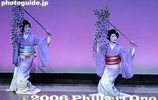
1. Fuji Murasaki (Purple Wisteria)
|
|

1. Fuji Murasaki (Purple Wisteria)
|
|

1. Fuji Murasaki (Purple Wisteria)
|
|
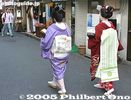
A geisha/geiko and maiko head to the theater to see the Kamogawa Odori. Notice the different obi sash on the back.A maiko is an apprentice geisha. Her obi sah on the back is long, as well as her sleeves.
|
|

Shimada hairstyleStandard hairstyle for geisha. This a wig.
|
|
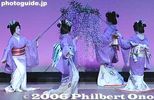
1. Fuji Murasaki (Purple Wisteria) by Kagurazaka geisha
|
|

Geiko and maiko in front of Pontocho Kaburenjo theater
|
|

1. Fuji Murasaki (Purple Wisteria)
|
|
|

1. Fuji Murasaki (Purple Wisteria)
|
|

1. Fuji Murasaki (Purple Wisteria)Dancer's name is Maiko 舞子
|
|

Her big round eyes makes her look like a real doll.
|
|

Maiko poses in front of the Naginata-boko float across the street in Kyoto
|
|
|

2. Sumidagawa (Sumida River)
|
|

3. Edo no Nigiwai (Liveliness of Edo)After this dance was a 20-min. intermission.
|
|

Kagurazaka geisha dance
|
|

1. Kagurazakari 神楽ざかり
|
|
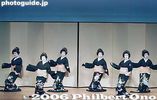
1. Kagurazakari 神楽ざかり
|
|

悋気しゃんすなSolo number performed by Maiko (her name). 舞子
|
|

1. Kagurazakari 神楽ざかり
|
|

2. Hitozato ひと里
|
|

3. 梅にも春 Ume nimo Haru
|
|

After the dance, this geisha posed with us for a picture.
|
|

Part 2: Passing of Spring in Kyoto, "Nanohanaya" (Rape blossoms) 菜の花やPart 2 of the program consists of dance numbers.
|
|

4. Sakura Kazashite 桜かざしてDancer 舞子 (Maiko)
|
|

"Nanohanaya" (Rape blossoms) 菜の花や
|
|
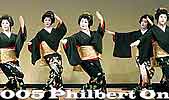
Finale
|
|

Maiko and geisha can often be seen in Gion.
|
|
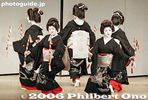
6. Hahha Kudoki ハッハくどき
|
|

Praying at Bishamon
|
|
|

Finale: "Hana Utage" (Flower Banquet) 花うたげ
|
|

Finale: "Hana Utage" (Flower Banquet) 花うたげ
|
|

Finale: "Hana Utage" (Flower Banquet) 花うたげ
|
|

Geisha on a palanquin, Toka Ebisu, Imamiya Ebisu Shrine, Osaka
|
|
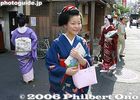
Geisha and Maiko in KyotoThis is in Pontocho, one of Kyoto's geisha districts. The woman on the left is a geisha (called "geiko" in Kyoto), the woman in the middle is a helper, and the woman on the right is a maiko or apprentice geisha. They are on their way to see the Kamogawa Odori dance performed by the Pontocho geisha in May.
|
|
|
|
|

Back of a Maiko, KyotoThe maiko is an apprentice geisha (or geiko). She can be easily identified by the long length of her kimono sleeves and the long length of her obi sash on her back.
See more photos of Kyoto geisha here.
|
|
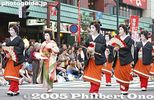
Edo Geisha. These geisha are from Asakusa, which also happens to be one of Tokyo's geisha districts. 江戸芸者
|
|

Edo Geisha江戸芸者
|
|

Edo Geisha 江戸芸者江戸芸者
|
|

Edo Geisha江戸芸者
|
|
|

Edo Geisha, She was the only one with a smile.
|
|
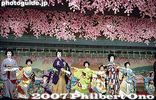
These dance photos were taken in April 2002. Note that taking pictures and videos of the dance are no longer allowed.
|
|

Edo Geisha江戸芸者
|
|
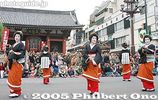
Edo Geisha portrayed by Asakusa geisha.江戸芸者
|
|
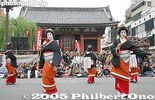
Edo Geisha江戸芸者
|
|

This was the only one who had a smile. The others were quite serious and solemn.
|
|

Tekomai Geisha, Fukagawa Hachiman Festival, TokyoTomioka Hachimangu Shrine in Fukagawa, Tokyo holds the full-scale Fukagawa Hachiman Festival every three years in August. It is a parade of over 50 portable shrines preceded by a troupe of tekomai geisha.
Their colorful costume is partially masculine with trousers instead of skirts. Their right shoulder is "exposed" to show a peony flower design. They carry a red paper lantern imprinted with their names and use their right hand to drag along a metal wand. As they walk, they only sing traditional chant-like songs. They do not dance.
See more photos of this festival here.
|
|

Geisha in my midst, in a taxi instead of a rickshaw.
|
|
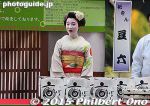
Maiko promoting a local product at Kyoto Station.
|
|

Waving these white streamers created a dazzling visual effect. It must have been either the wind or river.
|
|
|
|
|
|
|

Asakusa hangyoku (apprentice geisha in Tokyo). 半玉 千福
|
|
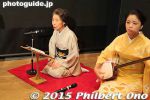
Tokyo's oldest geisha Yuko was an Asakusa geisha since age 16 and an unofficial Living Treasure of Asakusa. I was lucky to see her because she does not appear at every show.
|
|
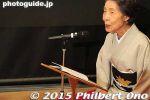
Yuko nee-san of Asakusa
|
|
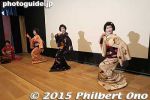
Asakusa Meibutsu (浅草名物)Song about Asakusa's many famous attractions like Matsuchiyama Shoten temple, Hanakawado, Hanayashiki Amusement Park, Sanja Matsuri, Sensoji temple, and Asakusa geisha.
|
|
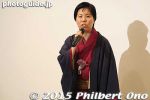
Hokan-gei (幇間芸) or Female male geisha (?)There used to be a few hundred male geisha in Japan. They were jesters providing comical entertainment. Now there are only seven of them, all in Asakusa. And she is the only female one. Call her a "female male geisha" (??).
|
|

Hakone geisha on rickshaw at Hakone Daimyo Gyoretsu
|
|

Tekomai geisha posing for photos.
|
|

Tekomai geisha
|
|

Asakusa Sanja Matsuri
|
|

Sanja Matsuri: Japanese buyo dance troupe from Muneyama-ryu (宗山流).
|
|

Sanja Festival
|
|

Yamagata maiko
|
|

Yamagata maiko
|
|
|
|
|
|